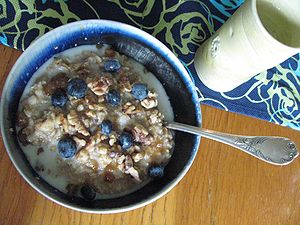 Image via Wikipedia
Image via WikipediaI would like to share with you this article from the Food for the Family page of the 2003 issue of Health & Home. I find this very interesting because it talks about oatmeal diet and the oatmeal advantage in obtaining a healthier life.
The article was written by Aida Cerdenola-Alarcon who works as dietitian at Manila Adventist Medical Center.
Eating oatmeal is good news for everyone who wishes to pursue a healthier life. It contains soluble fiber that has been demonstrated to be effective in lowering bad cholesterol.
Oatmeal, aside from being widely available, is also easy to prepare, tasty, and relatively inexpensive.
The Oatmeal Advantage
1.It lowers bad cholesterol. The most well-documented benefit of oatmeal on heart health is its effectiveness in lowering low density lipoprotein (LDL or bad cholesterol). Soluble fiber, which can be found in oats, barley, fruits high in pectin like guavas and strawberry, legumes, and psyllium, has been found to be effective in lowering cholesterol.
In two studies published in the Journal of American Medical Association, it was determined that 1/2 servings or 1/2 cups of cooked oatmeal is an appropriate daily target to reduce cholesterol. Real life situations have also proven oatmeal's cholesterol-lowering benefit. One hundred people from Colorado, USA, did just this by taking the oatmeal challenge. During the 30-day program, the participants volunteered to eat a bowl of oatmeal daily. After 30 days 98 percent of the participants had lowered their cholesterol level, with an average of 25 mg/dl. Those who stayed with the challenge had at least five to six percent reduction in cholesterol levels. By doing so, they have reduced their risk of heart attack by 10-12 percent.
2. Oats lower blood pressure. Since the late 1970s, more than 20 studies have been done to examine the relationship between dietary fiber and blood pressure. Overall blood pressure was significantly reduced regardless of age, weight, or other factors. The reduction was the response to the increase of soluble fiber intake.
Study made among hypertensive patients who ate oatmeal daily demonstrated a significant decrease in systolic pressure (8 mg/hg) and a close to significant decrease in diastolic pressure (3 mg/hg).
3. Oats may improve insulin sensitivity. Recent research suggests that soluble fiber may improve insulin sensitivity.
4. Oats may help control appetite. The soluble fiber in oats and oat bran absorbs a considerable amount of water significantly slowing the digestive process resulting to feeling full longer. Clinical studies evaluating this dietary fiber since the 60s support the soluble fiber sources and effective aids in enhancing satiety.
HOW TO COOK AN OATMEAL
You will need:
4 cups water
1 teaspoon salt
1 cup oatmeal
sugar (optional)
nonfat milk (optional)
Here's how:
1. Add salt and oatmeal to boiling water, stirring constantly.
2. Boil for 5-10 minutes. Set aside. The mixture may look watery at first, but will soon get to its right consistency.
3. Add sugar and/or milk as desired.

No comments:
Post a Comment